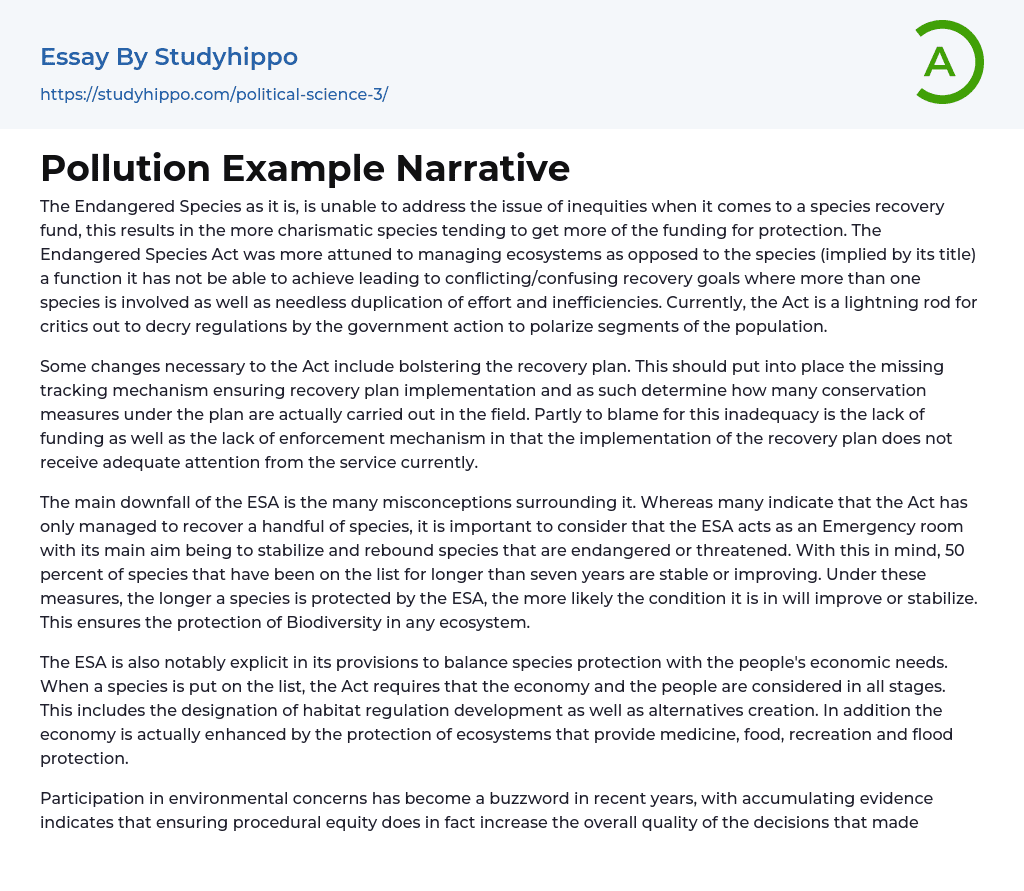The problem of unequal funding for species recovery is not effectively addressed by the Endangered Species Act, resulting in a disproportionate allocation of resources towards more charismatic species. Originally, the Act aimed to manage ecosystems rather than individual species but has been unable to fulfill this objective. As a result, when multiple species are involved, conflicting and confusing recovery goals arise while duplication of efforts and inefficiencies occur. Currently, opponents of government regulations criticize the Act, leading to divisions within society.
The Act mandates certain changes to reinforce the recovery plan, which include the implementation of a tracking mechanism to ensure its execution. This will aid in assessing the level to which conservation measures outlined in the plan are carried out in practice. The insufficient implementation is partly attributed to limited funding an
...d enforcement mechanisms, as it is not currently prioritized enough by the service. However, the primary concern with the ESA lies in the multitude of misconceptions surrounding it. While some argue that only a few species have achieved successful recovery under this Act, it is crucial to comprehend that the ESA functions akin to an Emergency room, aiming to stabilize and restore endangered or threatened species.
The ESA states that if a species remains on the list for over seven years, it has a 50% chance of stabilizing or improving. As a result, the longer a species is protected by the ESA, its chances of improvement or stabilization increase. This is crucial for preserving biodiversity in various ecosystems. Furthermore, the ESA aims to strike a balance between protecting species and meeting economic needs of individuals.
The Endangered Species Act requires considering the economy and population whe
listing a species. This involves regulations for preserving habitats and exploring alternatives. Additionally, protecting ecosystems with medicinal resources, food, recreation opportunities, and flood control benefits the economy. Recently, there has been increased focus on environmental involvement supported by evidence that fair procedures enhance decisions regarding natural resources and the environment.
The utilization of local knowledge that is typically inaccessible as well as increased acceptance of decisions can be achieved through this approach. Additionally, this inclusive method aids in addressing the diversity of interests, values, conflicting interpretations of both biophysical and social science analyses, and perspectives on how to handle uncertainty in hazardous waste management. The government can ensure fairness in the decision-making process by offering funding to participants. This resource serves to promote public participation, counteracting any inequities in procedures, and yielding both substantive benefits (such as enhanced positive effects and reduced adverse environmental impacts) and procedural advantages (like more effective public involvement).
Public education regarding the environment has the objective of enhancing environmental quality, fostering a community that emphasizes environmental protection, and cultivating individuals' decision-making skills. Through public education, the general population is empowered to actively engage in environmental preservation and protection initiatives. Consequently, well-informed individuals are able to lead various awareness campaigns and preservation programs, including water recycling, rainwater conservation, and large-scale environmental projects. Such efforts can only be sustained if the public possesses adequate education. Public education stands as the ultimate solution for addressing long-term challenges in water management, biodiversity, and hazardous waste disposal. In comparison, command and control policies have shown limited effectiveness in preserving and conserving the environment.
According to critics, the lack of balance between incentives and penalties is a major factor
contributing to non-compliance. The current policies typically impose small penalties that are rarely enforced. Additionally, these policies demand that politicians possess scientific knowledge in order to establish standards, which is both politically burdensome and unpopular with the public. As a result, the future of public policy making is shifting towards a market-driven cap and trade approach rather than a command and control method.
The cap-and-trade system establishes definite and enforceable restrictions on greenhouse gas emissions, enabling the market to decide on the most economical approaches for meeting these restrictions. Tradable permits or allowances for emissions are then issued in quantities that correspond to the total permitted emissions under the cap, either given out at no cost or through different actions. By attaching a worth to reducing pollution, this system encourages advancements in processes and technology with the objective of not only meeting but surpassing required pollution levels. This method is an all-inclusive and efficient means of formulating environmental preservation policies, exhibiting its capacity to effectively tackle ecological concerns through public policy.
- Environment Pollution essays
- Plastic Pollution essays
- Atmosphere essays
- Biodiversity essays
- Coral Reef essays
- Desert essays
- Earth essays
- Ecosystem essays
- Forest essays
- Lake essays
- Natural Environment essays
- Ocean essays
- Oxygen essays
- Rainbow essays
- Sea essays
- Soil essays
- Volcano essays
- Water essays
- Wind essays
- Air Pollution essays
- Carbon Dioxide essays
- Climate essays
- Deforestation essays
- Ecology essays
- Endangered Species essays
- Environmental Issues essays
- Environmental Protection essays
- flood essays
- Greenhouse Gas essays
- Hurricane essays
- Nature essays
- Pollution essays
- Renewable Energy essays
- Sustainability essays
- Tornado essays
- Traffic essays
- Tsunami essays
- Water Pollution essays
- Animal Welfare essays
- Climate Change essays
- Conservation essays
- Global Warming essays
- Plastic essays
- Recycling essays
- Waste Management essays
- Zoo essays




